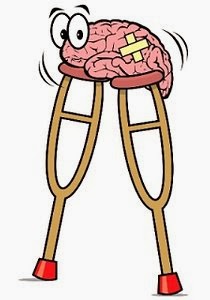The Rubber Band
The Rubber Band sits only on my hand.
Sitting there lifeless yet possessing such exuberance.
Oils and sweat excreting from each sweat gland comes in contact with its rubber.
Producing an adhesive feeling.
Confined to my skin, it stretches from east to west.
Such elasticity surprises its observers.
During its persistence to my hand, it can bind, wind and twined from end to end.
Its sticky ends on my fingers provides a stable platform of resistance.
Its persistence can be tricky.
It can align on your hand and your hair to prove its existence.
It is seen by none and coexists only with my mind.
-A Case of TBI (Traumatic Brain Injury)
Phantom/Tactile Hallucinations
Phantom or Tactile Hallucinations are both known to be a form of a compensation mechanism in the brain after sensory deprivation has occurred. Even though tactile hallucinations are present after nerve damage as described in the previous post, they can also be a symptom after direct brain damage as a result of Brain Injury.
Tactile Hallucinations that result after brain injury differ to Phantom Limb Syndrome, because they are mostly produced after direct brain damage rather then direct nerve damage. However, they are both similar in the way that neuronal cells rearrange themselves while rewiring occurs, and cortical neurons also distribute, expanding themselves to unresponsive areas (Purves 2008). After direct brain damage tactile memories are distorted and hallucinations arise. Tactile delusions and hallucinations occur as a result of direct injury to mostly areas of the Right brain including: somatosensory cortex, premotor cortex, parietal cortex, subcortical, temporal, and occipital lobe regions. The type of tactile hallucination depends on the brain region that has been damaged, but the most common are itching, bug crawls, seeing things that are not present, smelling things that do not exist. Feeling objects that are not actually there is also a type of tactile hallucination; for example the rubber bands that are felt and seen constantly in the case of a TBI that is described above (Gallance and Spence 2012).
Citations:
Gallance, A. and Spence, C 2012. "Touch and the body: the role of the somatosensory cortex in tactile awareness". Psyche, vol. 16, no. 1, pp.30-60.
Purves, D. and Augustine, G . Neuroscience. 4. Sunderland, MA: Sinauer Associates Inc., 2008. 857. Print.
Getting the Brain Injury Words Right. (n.d.). . Retrieved April 20, 2014, from http://www.brain-injury-online.com/brain-injury-what-is-it.html
The Rubber Band
The Rubber Band sits only on my hand.
Sitting there lifeless yet possessing such exuberance.
Oils and sweat excreting from each sweat gland comes in contact with its rubber.
Producing an adhesive feeling.
Confined to my skin, it stretches from east to west.
Such elasticity surprises its observers.
During its persistence to my hand, it can bind, wind and twined from end to end.
Its sticky ends on my fingers provides a stable platform of resistance.
Its persistence can be tricky.
It can align on your hand and your hair to prove its existence.
It is seen by none and coexists only with my mind.
-A Case of TBI (Traumatic Brain Injury)
Phantom or Tactile Hallucinations are both known to be a form of a compensation mechanism in the brain after sensory deprivation has occurred. Even though tactile hallucinations are present after nerve damage as described in the previous post, they can also be a symptom after direct brain damage as a result of Brain Injury.
Tactile Hallucinations that result after brain injury differ to Phantom Limb Syndrome, because they are mostly produced after direct brain damage rather then direct nerve damage. However, they are both similar in the way that neuronal cells rearrange themselves while rewiring occurs, and cortical neurons also distribute, expanding themselves to unresponsive areas (Purves 2008). After direct brain damage tactile memories are distorted and hallucinations arise. Tactile delusions and hallucinations occur as a result of direct injury to mostly areas of the Right brain including: somatosensory cortex, premotor cortex, parietal cortex, subcortical, temporal, and occipital lobe regions. The type of tactile hallucination depends on the brain region that has been damaged, but the most common are itching, bug crawls, seeing things that are not present, smelling things that do not exist. Feeling objects that are not actually there is also a type of tactile hallucination; for example the rubber bands that are felt and seen constantly in the case of a TBI that is described above (Gallance and Spence 2012).
Citations:
Gallance, A. and Spence, C 2012. "Touch and the body: the role of the somatosensory cortex in tactile awareness". Psyche, vol. 16, no. 1, pp.30-60.
Purves, D. and Augustine, G . Neuroscience. 4. Sunderland, MA: Sinauer Associates Inc., 2008. 857. Print.
Getting the Brain Injury Words Right. (n.d.). . Retrieved April 20, 2014, from http://www.brain-injury-online.com/brain-injury-what-is-it.html
Getting the Brain Injury Words Right. (n.d.). . Retrieved April 20, 2014, from http://www.brain-injury-online.com/brain-injury-what-is-it.html


